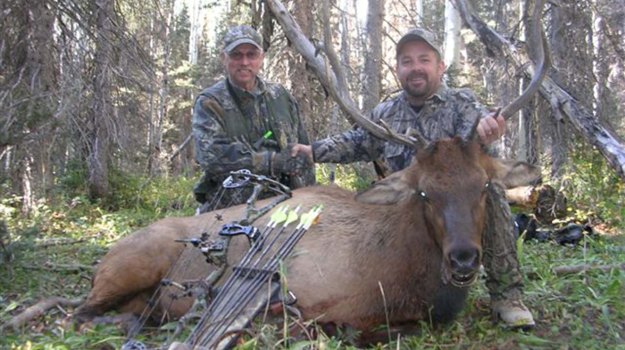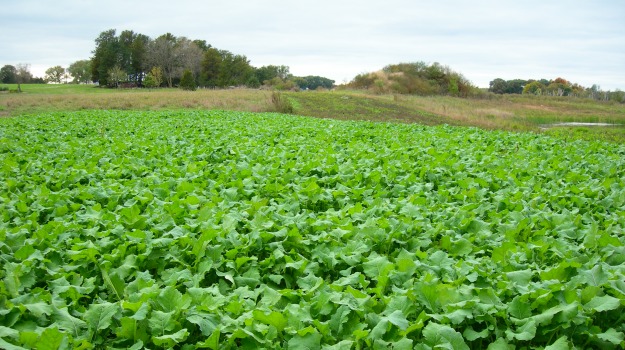
If Resident Summertime Bucks disappear, look to your Food Sources
By Brad Fitzpatrick
We had him! Chad McKibben, John Copas and I, sat huddled around Chad’s computer looking at pictures of a beautiful nine-point buck that came to feed as regularly as clockwork throughout the summer months. Game camera photos offered us a window into the buck’s life and helped us plot his movements with great precision. Now the only dilemma that remained was to decide which of us would have an opportunity to take him on opening day.
Then, just before the late September archery season opener, the buck vanished. We looked through a week’s worth of photos. There were other deer, though we saw fewer and fewer bucks. There were still a couple yearling bucks that ventured out to feed in the field from time to time. But not the big buck. He had gone from coming to feed regularly to absolutely avoiding the field altogether.
Between the three of us we thought of every possible scenario. Perhaps the buck was killed while crossing the road. Maybe we had spent too much time in and around the field and eventually scared the buck away. Perhaps something more sinister had occurred. Maybe the buck had been poached.
Truth be told, it was likely not something as insidious as a spotlighting hunter with a rifle that had caused our buck to disappear. We were just the latest in a long line of frustrated hunters who had seen their summer scouting totally derailed just before the opening of hunting season. Since our buck vanished I have paid close attention to stories from other hunters recounting the same scenario—a big buck is coming to a food source regularly and then, just before season, it suddenly drops off the radar. Most of the hunters I know attribute this to pressure, the dramatic influx of testosterone or the natural wariness of an old buck. In reality the reason for the sudden absence of a big buck at his favorite food source likely has more to do with biology than brains.
“The dietary needs of whitetails changes dramatically from late summer to early fall,” says Grant Woods, deer biologist and the host of Growing Deer TV. Grant has studied the dietary requirements of whitetail deer more thoroughly than almost anyone in the country and he has found that our vanishing fall deer may not be vanishing at all. They may be changing food sources to meet metabolic changes as they shift from a period of antler growth and milk production to the pre-rut.
According to Woods, deer crave protein-rich food sources during the summer months. By that time of year much of the deer’s caloric intake is dedicated to antler genesis and bucks are seeking out high protein foods like soybeans and clover. This summer diet provides the amino acids that fuel antler production and help build muscle and store body fat for the impending rut. Sometime in late summer, however, the deer’s nutritional needs change dramatically. As their dietary requirements alter, so are their movements.
“In the early fall whitetails change from a diet rich in proteins to a diet rich in carbohydrates,” says Woods. When I spoke with him he was familiar with the dilemma of disappearing deer and had heard many hunters say that they were frustrated by deer that suddenly and drastically changed their patterns only weeks before the opening of hunting season.
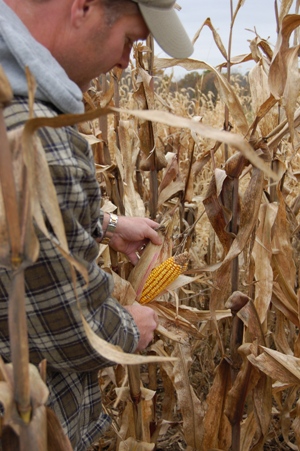 “When bucks are finished growing antlers and does are no longer nursing fawns their diet changes dramatically,” Woods says. Big bucks that have been religiously appearing in soybean fields every evening to fulfill their protein requirements during the last stage of antler genesis will suddenly switch to high carbohydrate foods such as corn, cereal grains or acorns. That bruiser deer that frequented the bean patch may well be just next door in a corn field or food plot of Outfitter’s Blend come opening day.
“When bucks are finished growing antlers and does are no longer nursing fawns their diet changes dramatically,” Woods says. Big bucks that have been religiously appearing in soybean fields every evening to fulfill their protein requirements during the last stage of antler genesis will suddenly switch to high carbohydrate foods such as corn, cereal grains or acorns. That bruiser deer that frequented the bean patch may well be just next door in a corn field or food plot of Outfitter’s Blend come opening day.
Grant also advises hunters to pay attention to subtle changes that indicate the shift from a protein-rich diet to a carbohydrate-rich diet. Typically the shift occurs about the time that the bucks’ antlers harden and lose velvet. Usually at around that same period of time soybean forage on most varieties will harden and become less palatable to deer. Hunters who monitor their stand sites or food plots with deer cameras may notice that the bucks lose their velvet and then drop out of sight very shortly afterwards.
“The change is driven by hormones,” Woods says. As the need to find protein slows and cold weather approaches bucks have to build fat reserves for the rut and the winter. Wise hunters understand this change and will be prepared, waiting at these carbohydrate-rich food sources until the deer appear.
For hunters this means that you will have to set up stands in areas where you are not seeing deer during the summer months. By understanding the seasonal changes in the diet of deer you will be in the right place on opening morning while so many other hunters are still clinging to that stand site where they saw the big bucks in August.
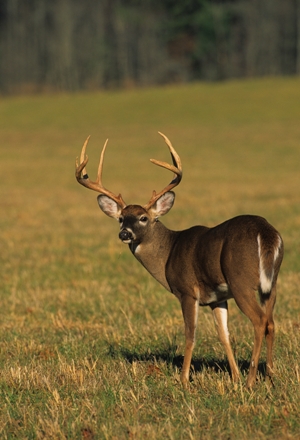 To understand changes in deer patterns in relation to diet it is important to understand the nutritional needs of deer throughout the year. Certain items will always be essential to a deer’s diet. Chief among these is fiber. As a ruminant animal, deer must eat a great deal of fibrous materials to maintain a healthy digestive tract. Fibrous foods like plant stems and grasses are rarely rich in carbohydrates or protein and so deer look to supplement their diet by adding various additional food sources that help them maintain a dietary balance in response to their environment. In the winter months, for instance, deer require a great deal of carbohydrates to maintain body fat and keep warm. The spring months provide ample natural food for deer but the emphasis shifts from carbohydrate sources to proteins during late spring as antler genesis and milk production begin to occur. From late spring until early fall deer maintain this quest for protein. Soybeans, Woods has found, are one of the whitetail’s favorite food sources. Alfalfa or clover also contain protein and can be a source of amino acids provided the legumes are maintained. However, maintaining perennials so they will produce quality forage requires time and effort.
To understand changes in deer patterns in relation to diet it is important to understand the nutritional needs of deer throughout the year. Certain items will always be essential to a deer’s diet. Chief among these is fiber. As a ruminant animal, deer must eat a great deal of fibrous materials to maintain a healthy digestive tract. Fibrous foods like plant stems and grasses are rarely rich in carbohydrates or protein and so deer look to supplement their diet by adding various additional food sources that help them maintain a dietary balance in response to their environment. In the winter months, for instance, deer require a great deal of carbohydrates to maintain body fat and keep warm. The spring months provide ample natural food for deer but the emphasis shifts from carbohydrate sources to proteins during late spring as antler genesis and milk production begin to occur. From late spring until early fall deer maintain this quest for protein. Soybeans, Woods has found, are one of the whitetail’s favorite food sources. Alfalfa or clover also contain protein and can be a source of amino acids provided the legumes are maintained. However, maintaining perennials so they will produce quality forage requires time and effort.
“Perennials are a good source of protein but once most of the plants produce blooms the protein drops significantly and it becomes less palatable”, Woods says. “For alfalfa or clover to produce top quality forage it needs to be cut several times a year.”
Prime carbohydrate-rich foods are corn and, to a lesser degree, acorns. Deer will shift to these food sources during the fall and will abandon protein sources like soybean forage in lieu of higher-calorie foods. This will continue all through the hunting season. In most areas this means that carbohydrates make up a high percentage of the whitetail’s diet during hunting season.
For plot managers it is important to understand these seasonal changes and to plant accordingly. Optimum antler growth is going to require ample protein-rich plants. But bear in mind that these same protein-rich plots that feed the deer through the summer months are not likely to be where those same bucks are harvested during the late fall. For optimum success food plots have to hold deer year round. This is achieved by meeting the nutritional needs of deer during every season. Variety is a key.
When considering seed blends take the time to analyze the protein content. For optimum antler growth high-protein foods must be planted in areas with good soil. The same holds true of carbohydrates. In fact, Woods says, your plant blend may not be as important as the quality of your soil.
“All plants are nutrient transfer agents,” Woods says. “If nutrients are not in the soil they cannot be transferred to the deer.” Plants, therefore, are simply a means of getting nutrients from the soil to the deer. It is absolutely essential that soil samples are taken and the ground is appropriately fertilized before plots are established.
“They did a study on antler growth in Mississippi”, Woods says, “and found that the counties with the most phosphorus in the soil always produced the biggest deer.” Effectively managing food plots requires good soil management as well as careful selection of seed blends that provide year-round feed for deer.
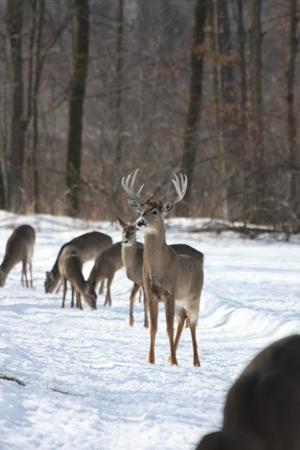 Many deer hunters and plot managers overlook the late winter and early spring, neglecting to provide supplemental feed or maintain existing plots since the hunting season is over. However, providing nutrition during this time of year is a key to producing inches of antler in the fall.
Many deer hunters and plot managers overlook the late winter and early spring, neglecting to provide supplemental feed or maintain existing plots since the hunting season is over. However, providing nutrition during this time of year is a key to producing inches of antler in the fall.
“If food sources are available in the winter and early spring deer will be healthier. Bucks can invest more nutrients in growing antlers instead of playing catch-up after the winter months,” says Woods.
Successful deer management requires twelve months of dedication annually. By understanding the differing nutritional needs of deer from one season to the next and planting accordingly you will not only up the odds of having bigger bucks on your camera in late summer but you will also increase your chances that those big bucks will still be around during the hunting season.
Buck photo 1: Twildlife | Dreamstime.com
Buck photo 2: WildOutdoorPhotos.com














